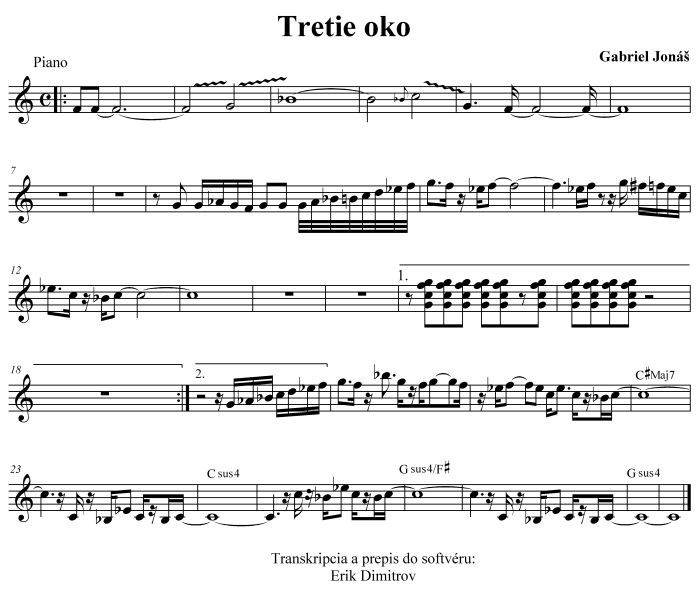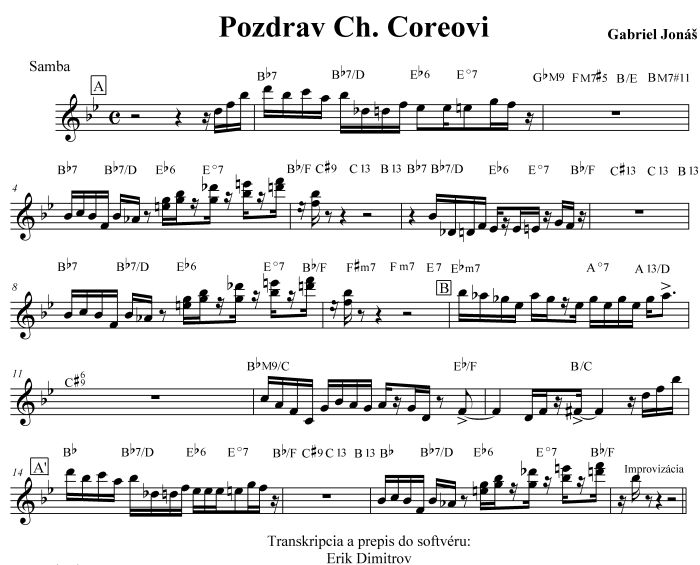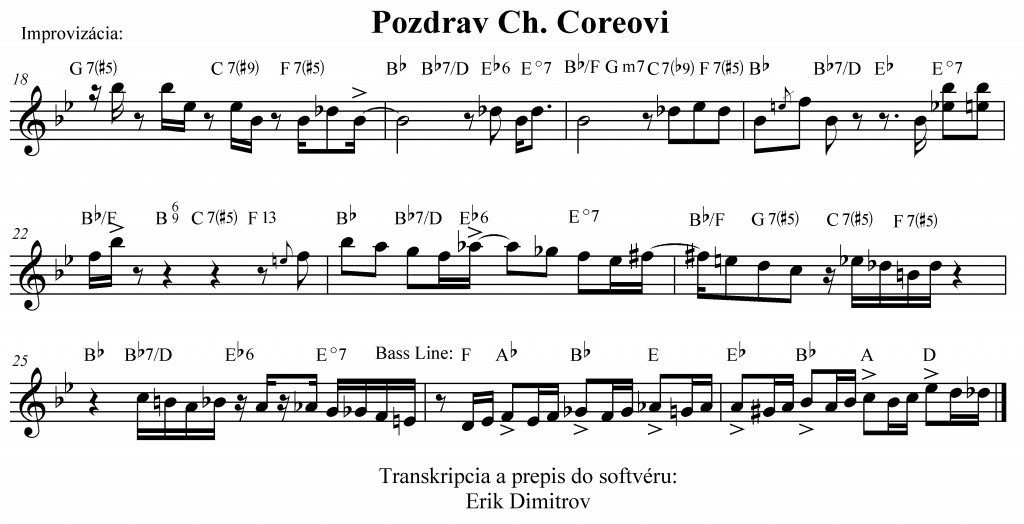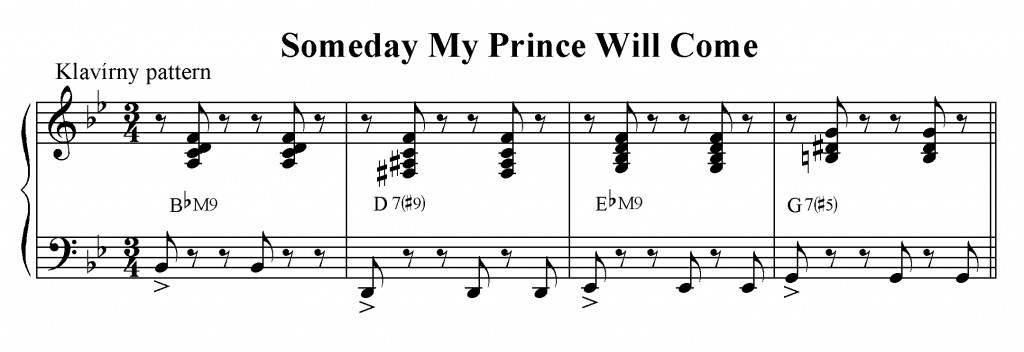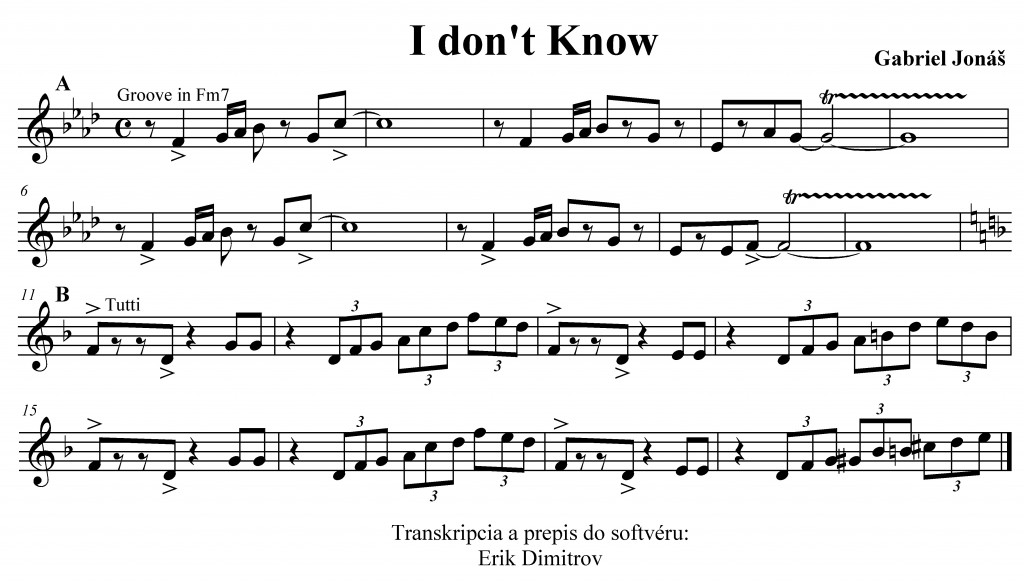Abstract:
Gabriel Jonáš is a leading Slovak jazz musician. He has made major contributions in shaping the Slovak and Czech jazz scene since the 1970s. The paper focuses on Jonáš’ most significant artistic, compositional and performing activities from jazzrock through to fusion music, and into modal mainstream. Using sheet music transcripitons and recordings, the author demonstrates the influence of American jazz on Jonáš’ compositions and also the progression of Slovak jazz development.
Jazz pianist, composer and arranger Gabriel Jonáš represents the acme of the Slovak jazz. He graduated from the Bratislava Conservatory (1969) where he had studied the accordion and guitar playing. However he also played the saxophone, bass guitar and other instruments on a professional level. Later he cast aside all other instruments except the keyboards. Originally he was inspired by jazz records by pianists Oscar Peterson and David Brubeck, which motivated him to the comprehension of jazz performance and creation of his own jazz pieces. As early as in 1969 he was admitted to a jazz school in Austrian Graz and in 1973 to Berklee School of Music in Boston, but for various reasons he did not start his studies. In 1972 he got to New York jazz clubs where he acquired unique experience. He performed there with world-wide famous American jazzmen as Joe Newman and Atilla Zoller. Returning to Slovakia he started to cooperate with several musicians. For a short time he collaborated with significant Polish singer Czeslaw Nieman and with Slovak jazz-rock band GATTCH, where he played the bass guitar.
For the first time Gabriel Jonáš presented himself publicly in Czechoslovakia in 1975 at the Kroměříž Non-Professional Jazz Festival. He performed there in a duet with drummer Jozef Döme and won the best Czechoslovak jazz soloist award. A jury member of the festival, the flutist and saxophonist Jiří Stivín asked Gabriel Jonáš for a collaboration. It was at the time when Stivín’s Tandem with guitarist Rudolf Dašek broke up. Thus Gabriel Jonáš got the open way to Prague jazz scene and started to gain fame also among the Slovak audience. Next two years Jonáš and Stivín performed together and recorded the LP Zvěrokruh (The Zodiac) in 1977.
LP Klávesová Konkláva [Keyboard Conclave]
In 1976 a special concert was recorded in Prague where Gabriel Jonáš and two other pianists, Emil Viklický and Karel Růžička, performed with jazz-rock rhythm section. Two years later the record from the concert was released on the LP Keyboard Conclave. It was rated with the highest marks by the critics and it is outstanding from several aspects. The record uses the stereo panorama principle, thus when reproduced the instruments are separated into particular sides of the record. The electronic keyboards of Emil Viklický and Karel Růžička can be heard in the left and right channels respectively, while the acoustic piano by Gabriel Jonáš stands in the middle. The audio spectrum of the album is very rich despite the fact that it was recorded live. All three pianists attained the stylistically common language based on contemporary recordings of the piano players Les Mc Cann, Herbie Hancock and Joe Zawinul. Original compositions of the pianists form the core of the album.
The first, more than 11-minute composition Tretie oko [The Third Eye] by Gabriel Jonáš uses the G Phrygian mode as its main key. The piece begins with an electric piano repetitive pattern on D, C, A Flat, G. This layer is joined gradually by the rhythm section and then immediately by the theme played on the piano. In it the long sustained tones alternate with quick and rhythmic phrases. At the end of the theme the section of a common tutti phrase emerges, where two kinds of chords appear: Maj or major seventh chord, and suspended fourth, the chord in which the third is replaced by the perfect fourth. Thus except the common tutti passage the harmonic outline of the piece consists of the alternation of two basic modes, Phrygian on the first grade and Lydian on the second diminished grade (on A Flat). Over these alternating modes the improvisation of all three pianists continues, supported mainly by the rhythm section of bass guitar and percussion instruments. While the soli continue, harmony is rarely emphasized in chords. The pianists use only a game of phrases and their audio nuances to fill the musical space. Compared to the piece Spain by Chick Corea the Third Eye is more focused on rhythmics and phrasing of particular soli than on harmony. Only samba groove, the characteristic rhythmic pattern in the bass guitar and in the drummer’s rhythms, resembles Chick Corea’s Spain. At the end of all improvisations the tutti passage comes without the original theme. Compositional devices like the usage of Maj and Sus chords or modal improvisations were typical especially for Chick Corea at that time who inspired Gabriel Jonáš to a certain extent. Let us mention here that jazz recordings, as well as note material or other information regarding the jazz trends in the world were achievable only with great difficulties at the time. The recording studios and music publishing houses were almost inaccessible, as they were focusing on the recording of classical and traditional music. Thanks to his travels abroad Gabriel Jonáš brought several precious jazz LPs, his source of inspiration.
Throughout the album the pianists inspire and complement each other. They do not strive to surpass each other, they alternate in taking the main role. A valuable rhythm section – Peter Kořínek (bass guitar) and Jozef Vejvoda (percussion instruments) – supported the soloists to a great extent. The following pieces of the album prove the variegated thinking of particular authors. Karel Růžička presents his more soul-like inclination, while Emil Viklický joins the traditional elements with jazz, namely the melodics and tonality of Moravian folk music, which enter his play. This diversity of performers resulted in interesting stylistic enlacement of three personalites at the album and added a hallmark of uniqueness to it.
Example: Keyboard Conclave – The Third Eye
The album Keyboard Conclave is a rare recording of the grouping of musicians at the Prague Jazz Days and it is unique from the historical point of view regarding jazz pianists in Central Europe, as it presents piano duets in the time when solo piano and piano duets in the U.S.A. jazz world only started to blossom. One of the first solo piano jazz album was Staircase by Keith Jarrett in 1976, and the first piano duet of Chick Corea and Herbie Hancock was released only in 1978 on an LP, and similarly to Keyboard Conclave it was a recording of their joint concerts.
LP Impresie [Impressions]
The most self-contained document of Gabriel Jonáš’s composing, arranging and performing endeavours is his LP Impressions released by Opus in 1978. At that time he had no permanent line-up, therefore he invited the acme of Czech jazz for the recording, the saxophonist Petr Král, the double-bassist Petr Kořínek, drummer Jozef Vejvoda and percussionist Jiří Tomek. Gabriel Jonáš himself labelled them as the best coordinated rhythm section in the whole of Czechoslovakia.
The musicians had only a short time span of two days for the recording, being offered a free term in the Prague studio Mozarteum at the last moment. Seven pieces form the album Impressions, six by Gabriel Jonáš and one by Petr Kořínek. The title of the record refers to Jonáš’s jazz self-realization which uses new audio possibilities of the piano music of the then jazz mainstream.
An important piece of the album is Greeting to Ch. Corea, dedicated by Jonáš to one of his music paragons. Jonáš got his hands on Corea’s studio recordings for the first time in 1969. In the run of nine years he developed a close relation to Corea’s music and inspired himself by his accomplished jazz piano artistry. This inspiration resulted in his own composition amalgamating the elements of music by Chick Corea and his own motifs.
The piece Greeting to Ch. Corea uses a South American samba rhythm, preferred also by Chick Corea himself in his compositions. Characteristic sound ambience is joined by percussion instruments: claves and triangle. The introduction is opened by a percussion rhythmic pattern, later supplemented by two minor chords Gm7 with the bass F and Am7 with the bass D Flat, repeated once. They are followed by a theme on the piano, interesting especially by the variations of the two measure phrase. The first measure is special by its agile melodic line and the second one consists of variously rhythmized alterations of the chords. The piece is in Bb major and tectonically the first section (A) consists of four two-bar phrases. Harmony of the first bar of the phrase is created by a tonic triad, its first inversion, subdominant triad and non-tonal seventh grade to the dominant. The second measure of the phrase is harmonically varied with the base in a widened cadence. The section (B) has a modulating character, while each measure is in a different key. The section (A’) is half the extent of the section (A) and Gabriel Jonáš recalls the main motif of the composition with the following piano solo.
The melodic outline of the solo is distinctive and supported by a special harmony. The opening part of the piano solo is created namely by the tones of the Bb blues pentatonic key. In the 10th bar of the solo (26th bar of the score) Jonáš leaves this diatonic basis of the composition and together with the bass line he goes through various chromatic sequences and permits the piano to sound in a wide scale of colours. The most interesting is Jonáš’s sense for rhythm and a creation of new rhythmic patterns. By using breaks frequently he creates a strange rhythmical elasticity and his unique rendering shifts him into the class of American jazz musicians.
Example: Greeting to Ch. Corea
Together with his co-players Gabriel Jonáš contributed to the origin of a representative sample of jazz of the 1970s. Following Ladislav Gerhardt he thus became another significant representative of the Slovak jazz piano generation of the second half of the 20th century. The turn of the 1980s brought the climax of his music career. Two years after the album was released, in 1980 Jonáš performed at the Bratislava Music Festival both as a soloist and in a duet with Emil Viklický. From 1983 he used to perform with the jazzrock band Esprit and occupied himself predominantly by a solo play. In 1985 he again performed at the Bratislava Music Festival in a duet with Cuban percussionist L. A. Barrer-Perao. During 1990 – 1993 he played in a duet with double-bass player Robert Balzar, guitarist Matúš Jakabčic, trumpet player Juraj Bartoš and continued his collaboration with Jiří Stivín.
LP Gentle Rain
The second studio album by Gabriel Jonáš got an English title Gentle Rain after the homonymous piece by Brazilian guitarist and composer Luiz Bonfá. It was recorded 12 years after the first album Impressions in the after-revolutional time of 1990. Despite the fact that Gabriel Jonáš used to perform publicly with some music ensemble, he decided to record this album by himself, without any other player. He compensated for it by the recording technology called “overdubbing”. The particular simultaneously sounding components of the music work were recorded successively on separated sound tracks. By this way step by step Jonáš recorded all three piano parts into one composition. The album consists of 10 pieces, 8 of them being American jazz standards and 2 are original pieces by Jonáš’s.
The song Some Day My Prince Will Come was subject to a very non-traditional elaboration. Originally a movie soundtrack to Snow White and the Seven Dwarfs from the Disney studios turned into a jazz standard several years later. It was performed by a huge number of jazzmen like Miles Davis, Dave Brubeck, Oscar Peterson and others and thanks to them the piece has acquired many different forms. Gabriel Jonáš also arranged the piece very originally. As the majority of the arrangements of the piece are in a mild tempo and 3/4 metre, G. Jonáš focused especially on the re-arrangement of its rhythmical accompaniment. After a short calm introduction a quick new pattern enters, tinting the theme and a major part of the piano solo. Similar patterns occur on the album in the other, less famous jazz standard I Hear the Rhapsody, however, much more polyrhythmic elements are used here. This is related also to Jonáš’s close relationship to African traditional music, where polyrhythm is highly developed.
Example: Some Day My Prince Will Come
Apart from jazz standards Gabriel Jonáš composed also two original compositions for the album Gentle Rain. The first one, Song for Sandra, fits well to the dramaturgical concept of the album and in its quality it equals American standards. The other original piece of Jonáš entitled Tail is, contrary to the Song for Sandra, structurally closer to classical music and exceeds traditional jazz standards. The bass line tinges the whole piece, its fifth-octave jumps are diversely rhythmically varied. The harmonic layer is typical by harmonies in seconds, thirds and in clustres and together with the bass line it results in interesting rhythmic-harmonic patterns. The melodic layer is the most pithy encompassing also the opening theme, as well as the main part of the improvisational passage. In his improvisation Jonáš often uses rhythm variations together with short melodic phrases. The overall sound of the composition Tail is of an ethereal and melancholic character evoking a certain amount of restlessness.
The album Gentle Rain is in itself a testimony to Gabriel Jonáš’s interpretation. Besides two original compositions he had elaborated here significant jazz standards of such giants as Herbie Hancock, Charlie Parker, Luzi Bonfa and others. Jonáš presents here his performing ripeness and professional progress. However, this album did not become exceedingly popular, apart from other reasons also due to the social-political atmosphere and after-revolutional changes typical for the early 1990s. In spite of this Jonáš was awarded the best jazz musician of the year prize at the festival in Karlovy Vary in 1991.
In the same year he recorded the album Far and Yet Near with Matúš Jakabčic and Robert Balzar, which met with large response. The primary idea was not the concept of a diminished traditional quartet, but the presentation of three equal instruments. For instance the piece Touches reveals the easiness of the composer’s brilliant piano technique and thematic lushness. Balzar’s double-bass is not only the second aide, but due to its vividness it is an independent melodic companion. It is especially this mutual conversation which is the most exciting ligament of the whole album. In 1992 Jonáš was awarded the Ladislav Martoník Prize as the jazzman of the year. His collaboration with the spiritual singer Jana Kocianová in 1994 was also interesting, they recorded the album Spiritual from the Heart. By this way Jonáš confirmed his inclination towards the jazz sources.
CD Gabo Jonáš Quartet – Live
The third album by Gabriel Jonáš is a live concert recording. The concert was made possible thanks to the international programme Euroradio Jazz Season 2001 – 2002, organized by the European Broadcasting Union and aired into 16 European countries, for the first time with Slovak participation. Gabriel Jonáš invited the cream of the Slovak jazz scene for the event: Juraj Griglák (double-bass, bass guitar), Martin Valihora (percussion instruments) and Radovan Tariška (alto saxophone). The concert crowned their concert tour in Slovakia. Besides classical piano Jonáš plays the synthesizer and creates interesting sound spaces and effects. All seven compositions of the album were composed and arranged by Gabriel Jonáš. The preceding albums were mostly in modal and mainstream jazz style, but this album oscillates among the ranges of jazzrock, fusion and funk style. The only exception is the mainstream opening piece of the album I Don’t Know. Liberal time possibilities of the live album enabled the performers to elaborate their improvisational passages to perfection, what is exemplified by the more than three-minute piano solo of the opening piece. In it tonal digressions, sequences and harmonic-melodic variations are frequently used by Jonáš. Its music is very interesting and confirms Jonáš’s rich invention and virtuosity. The saxophone solo is extremely concise and its phrases correspond with the distinctively pulsing rhythm section.
Example: I Don’t Know
The second piece of the album Song for Sandra comes originally from the album Gentle Rain. However, in this new arrangement the theme was taken by the bass guitar which added to it a more tuneful character. Each following piece of the album has its typical groove, over which the themes of the keyboards and saxophone excel. The top Slovak rhythmics considerably struck a blow for first-rate grooves and accentuated the high-quality of Jonáš’s compositions. He chose the music to meet the stylistic tastes of his co-players and to illustrate their skills absolutely. Quoting Gabo Jonáš “this recording demonstrates spontaneous musicality – what every one was able to ‘unpack’ in the given moment”; craft, emotionality, expression. Musicians, he said, had “no time for a longer co-ordination. But with such a line-up it was not possible to record it badly. It is at the same time variegated and vivid.”1
Gabriel Jonáš has collaborated with other significant jazzmen, such as Peter Cardarelli, Juraj Bartoš, Peter Lipa and others. Recently in 2012 he participated in the recording of the albums Personal Suite and New Winter Stories of the saxophonist Nikolaj Nikitin, where also famous American trumpet player Michael Patches Stewart took part. A well-known Czech jazz theorist Antonín Matzner characterized Jonáš’s playing: “Everything is like woven from optimal harmony of his introvert temperament with extremely refined rendering, which often results in richly segmented structures and expressive strain even while using minimal devices.”2 (Praha, 1978).
Notes
- Jaslovský, Marián: Jonáš: Život v rytme džezu, www.sme.sk, 2003.
- Matzner, Antonín: Sleeve notes on LP Impresie (9115 0729), Opus, 1978.
Bibliography
Dorůžka, Lubomír – Poledňák, Ivan: Československý jazz-Minulost a přítomnost, Editio Supraphon, Praha, Bratislava 1967.
Gridley, Mark: Jazz Styles. History and Analysis, Sixth ed., Prentice Hall, New Jersey 1997.
Kajanová, Yvetta: Communism and emergence of the Central European Jazz School, In: Journal of literature and art studies, vol. 2, 2012, No.6, pp. 622-640.
Kajanová, Yvetta: K dejinám jazzu, Coolart, Bratislava 2010.
Kajanová, Yvetta: K periodizácii slovenskej populárnej hudby a jazzu. In: Slovenská hudobná kultúra – kontinuita, či diskontinuita? Fakulta prírodných vied Žilinskej univerzity, Katedra hudby, Bratislava 2007, BEN&M – KH FPVŽU, Žilina 2007.
Kajanová, Yvetta: Sprievodné a významové komponenty jazzu v období 1948-1989 na príkladoch slovenského jazzu. In: Príspevky k vývoju hudobnej kultúry na Slovensku. Stimul, Bratislava 2009, s. 183-214.
Kajanová, Yvetta: Jazzoví klaviristi v strednej Európe v období 1948-1989. In: Slovenská hudba 20. storočia v pohľadoch a kontextoch. Bratislava : UK, 2011, s. 123-163.
Lyons, Len: The Great Jazz Pianists, Da Capo Press, New York 1983.
Müller, Richard: Koncert Gabriela Jonáša, in: Populár, vol. XI, 1979, No. 9, p. 12.
Snopko, Ladislav: Gabriel Jonáš – šedá eminencia nášho jazzu, in: Populár, vol. XI, 1979, No. 6, pp. 10-11.
Snopko, Ladislav: Gabriel Jonáš – Impresie, in: Populár, vol. XI, 1979, No. 6, p. 27.
Španko, Patrick: Gabo Jonáš : Slovenskí inštrumentalisti, in: Rytmus, vol. 41, 1990, No. 10.
Wasserberger, Igor: Slovenský džez, in: Populár, vol. XIII, 1981, No. 3-8.

